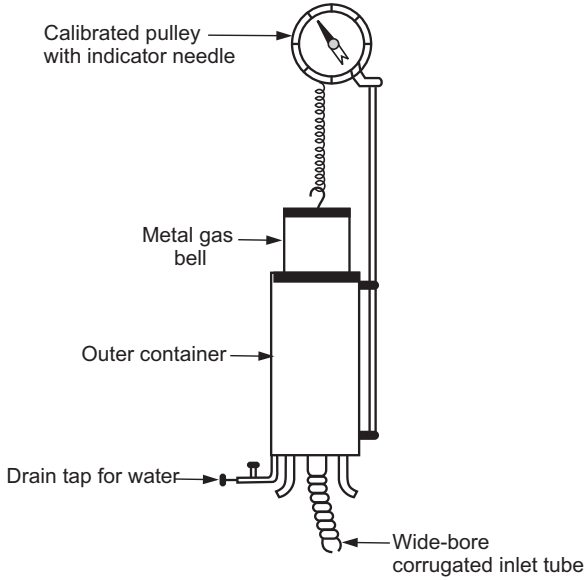Aim: To determine the tidal volume and vital capacity.
Requirements: Spirometer; potassium permanganate solution. The spirometer consists of a double-walled metal cylindrical chamber, with a light metal gas bell of 6 liters capacity floating in an outer container filled with water. The water acts as an airtight seal. The bell is attached to a chain on its upper end which passes over a graduated frictionless pulley. The pulley has a spring-mounted indicator needle that indicates the volume of air present in the bell. The gas bell is counterbalanced by a weight attached to the other end of the chain for a smooth up and down movement of the bell. The inlet tube is a corrugated canvas-rubber tube with a mouthpiece through which air moves into or out of the bell. This tube is attached to a metal pipe at the bottom of the spirometer. When air is blown into the inlet tube, it raises the bell in the container.
Theory: Vital Capacity (VC) is the largest volume of air that a person can expel from the lungs by forceful expiration after forceful inspiration. It can be measured using breathe measuring device called a spirometer (simple or recording).
A simple spirometer is a low-cost and conventional instrument commonly used on the laboratory scale whereas a recording spirometer is a sophisticated, electrically-driven instrument with a recording system and widely used in respiratory physiology laboratories and hospitals.
The graphical recording of the spirometer is called a spirogram in which inspiration is recorded as an upward deflection and expiration as a downward deflection.

The volume of air in the lungs changes considerably during a respiratory cycle which can be distinguished as four different lung volumes:
- Tidal Volume (TV): It is the amount of air that moves into the lungs with each inspiration (or the amount that moves out with each expiration) during normal quiet breathing (tidal respiration). Normal TV is about 500 ml.
- Inspiratory Reserve Volume (IRV): It is the volume of additional inhaled air during deep breathing. It is about 3100 ml above the TV.
- Expiratory Reserve Volume (ERV): It is the extra volume of exhaled air during forced expiration. It is about 1200 ml in addition to the TV.
- Residual Volume (RV): It is the volume of air remaining in the lungs after the expulsion of ERV. It amounts to about 1200 ml.
The combination of specific lung volumes gives lung capacities. The vital capacity (VC) is the total amount of air that can be exchanged between the atmosphere and lungs during normal and forced respiration. It is calculated as:
Vital capacity (VC) (4800 ml) = IRV (3100 ml) TV (500 ml) ERV (1200 ml)
Normal vital capacity ranges between 3.5 and 6 liters. It is used clinically as an index of lung function and gives information about abnormal ventilation due to respiratory diseases.
Procedure:
- Select one healthy subject for the demonstration.
- Bring the bell to its lowest position by gently pushing it down. Adjust the pointer needle to zero, which indicates that the bell is empty.
- Make the subject stand comfortably, facing the spirometer to see the movement of the bell.
Measurement of Vital Capacity:
- After normal breathing for one minute, ask the subject to breathe as deeply and forcibly as possible to fill the lungs.
- Ask him/her to close both the nostrils with a thumb and fingers, and hold the mouthpiece firmly between the lips.
- In this position, ask to expel all the air with maximum effort into the spirometer. The bell moves up and the pointer on the pulley indicates the volume of expired air (The forced expiration should be deep and quick but without excessive speed).
- Take two more readings at an interval of 5 minutes.
- Repeat this procedure in a sitting position.
Measurement of Tidal Volume:
- Ask the subject to breathe normally (quiet breathing) for one minute.
- Ask him/her to close both the nostrils with a thumb and fingers, and hold the mouthpiece firmly between the lips.
- In this position, ask him/herS to expel the air with normal expiration. The bell moves up and the pointer on the pulley indicates the volume of expired.
- Take two more readings at an interval of 5 minutes.
- Repeat this procedure in a sitting position.
Observation table:
- Name:
- Age:
- Gender:
- Weight: …… kg
- Height: …… cm

Make sure you also check our other amazing Article on : Recording of Body Temperature
